* (restored/expanded)
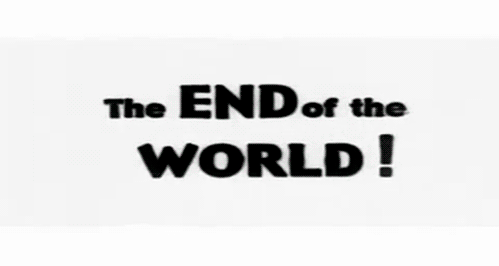
‘Over the course of a career that has spanned nearly two decades and 25 films, both short and feature, filmmaker Guy Maddin has provided his viewers with more than their fair share of unique, cinematic moments. To provide just one example, in Tales from the Gimli Hospital (1988), his first feature film, the audience is allowed to watch as one of the director’s many eccentric characters, a male who is attempting to make himself more attractive to the ladies relaxing on a nearby beach, disappears behind a dilapidated building, troubled that his hair is dry and in such a mess. At this point, the audience may expect that some grooming is in order, but most first time viewers could never predict how such a grooming process will eventually unfold. Out of sight from the women, the character manages to find a shiny, dead fish, which he then squeezes frantically over his head, until its guts are wretched open, spilling fish oil all over the man’s hair. The character soon reemerges, hair slicked back and full of fish oil. He is now ready to properly swoon the ladies still lying on the sands of Gimli beach.
‘Keeping such a distinct image of a fish in mind, it may be appropriate to consider the career of Maddin in relation to the old cliché about the size of a fish as being relative to the size of the pond that it lives in. In the pond of the Manitoba film industry, he is easily the biggest fish there is. Since making his first short in 1986, titled The Dead Father, Maddin’s reputation has, for the most part, only continued to grow with each subsequent project. The fact that he has remained a resident of his hometown, the provincial capital of Winnipeg, throughout his entire life, has only added to his recognition as a Manitoba filmmaker.
‘Within the pond that is the Canadian film industry, Maddin as fish becomes a bit smaller, having to make room for bigger fish that arrived before him, such as David Cronenberg as well as filmmakers that emerged on the scene at around the same time as Maddin, but have perhaps managed to achieve more far reaching success, at least in their attempts to capture both an international audience, as well as international, critical recognition. Atom Egoyan would be the most obvious example of a successful contemporary director who lives and works in Canada, but whose recognition extends well beyond Canada’s borders.
‘That said, Maddin’s exposure has grown considerably in the past few years. In 2000, as part of the Toronto Film Festival’s twentieth anniversary celebration, 20 Canadian filmmakers, including Maddin, Cronenberg, and Egoyan, were each commissioned to make a short film. The resulting twenty shorts randomly played before feature films throughout the entire festival. By the festival’s conclusion, Maddin’s short, titled The Heart of the World, a six minute, furiously edited, black-and-white masterpiece, was considered by many festival goers and critics to have been not only the best short to play at that year’s festival, but to have been the best film of any length to play during the entire festival run. Since the release of The Heart of the World, he has continued to work steadily, completing several short films, as well as a pair of feature films, one of which is to be released later this year. Co-written by Maddin’s long-time writing partner, George Toles, as well as Kazuo Ishiguro, Booker Prize winning author of The Remains of the Day, The Saddest Music in the World (2003), may well turn out to be the film that shows the world what many Manitobans and Canadians, as well as several cinephiles and professional film critics from around the world, have already known for years: that Guy Maddin is one of the most original, important filmmakers working today, regardless of geography or genre.
‘Born in 1956, Maddin seemed destined to live a life that would breed uniqueness and eccentricity at every turn. His father was a prominent hockey coach, as well as the business manager of Canada’s national team, while his mother ran a beauty salon named Lil’s Beauty Shop. And so, Maddin would spend many of his childhood days at either the Winnipeg Arena, seeing some of hockey’s all-time greats both in practice and behind-the-scenes, or else he could be found playing with his older brother and friends at his mother’s beauty salon. Even the way that Maddin tells stories about himself and his family, from receiving a piggy-back ride from Bing Crosby, to getting a cold from a cousin that resulted in a neurological infection and the permanent, persistent sensation of feeling like he is constantly being touched by ghosts all over his body, to finding out that his father was blinded in one eye as a child, because his father’s mother had attempted to hold her son against her breast, but had accidentally poked his eye out with the pin from an open broach, indicates that Maddin either possesses an especially keen eye for life’s little oddities, or else he has genuinely experienced what many people would consider an existence filled with extreme unusualness.
‘When Maddin was still a young boy, his older brother committed suicide, and while he does not often talk about it, suicide has certainly become a prominent theme that runs throughout his body of work. For that matter, fathers with missing eyes also frequently appear as characters in Maddin’s films, and so, no matter how fictional and exotic the director’s landscapes may seem, they are often fused with pieces of his own autobiographical history.
‘After graduating with a degree in economics from the University of Winnipeg, Maddin worked as both a bank teller, as well as a house painter, while meeting people whose friendships would serve him well, especially in terms of being able to eventually get his first films made and distributed. As fellow Winnipeg filmmaker, John Paizs, tells it, Maddin and himself would spend entire weekends at the house of fellow friend Steve Snyder, before any sort of formal film school existed in Winnipeg, and would watch hours upon hours of films on videotape and 16mm projection. Eventually, Paizs would go on to make several excellent short and feature films of his own (Springtime in Greenland [1981], Crimewave [1985]), while Snyder would go on to teach film studies as a professor in what would eventually become the University of Manitoba’s film studies department.
‘Even as Maddin was watching his friends make and teach about films, he had yet to make any sort of film on his own. However, in 1985, with the creation of a cable access television show, titled Survival!, in which Maddin played a character named “Concerned Citizen Stan”, while acting alongside his eventual producing partner, roommate, and friend, Greg Klymkiw, the seeds of his creativity began to show some definite signs of life. That same year, Steve Snyder, after screening several shorts that he had made while attending a filmmaking school in San Francisco, California, told Maddin that with the right equipment, he too could make a film just like the ones he had just seen. And so, Maddin finally decided that it was time to write and direct a film that he could call his very own.
‘The resulting film, a 26 minute short, titled The Dead Father, is by far Maddin’s clunkiest work, in terms of both technical prowess and narrative smoothness, and yet, at the same time, the film does not come across as the work of someone who had never written a screenplay or touched a camera before making it. In fact, with his first film, he managed to lay down the framework for so much of what would become his later, consistent style. In The Dead Father, he reveals an obsession with black-and-white cinematography, an interest in opening his films with a series of constantly moving shots—a technique that he has continued to employ in several of his subsequent works—as well as the use of only a singular light source to illuminate his shots. Maddin has actually said that the rationale behind many of these choices is quite simple. By repeatedly opening his films with a moving camera, he easily gets the viewer’s attention from the first shot of the film. As far as lighting is concerned, Maddin has admitted that while he tried to use the traditional three-key lighting set-up that so many first time filmmakers read about in technical handbooks, while making his first film, all that he would end up with were three shadows of one nose on each actor’s face. Since then, he has employed a single light source technique in most of his films, or at least the illusion of a single light source.’ — Jason Woloski
_____
Stills
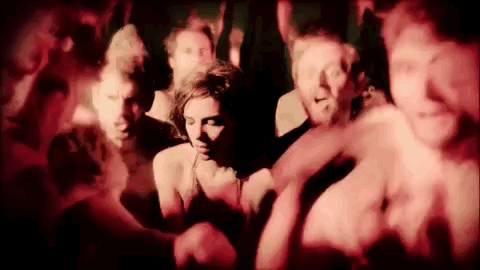
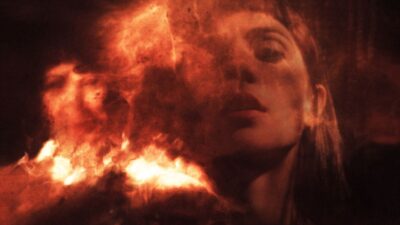
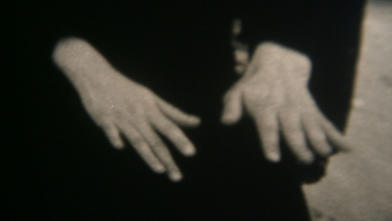





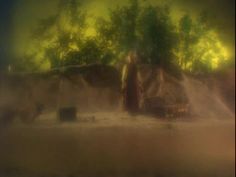

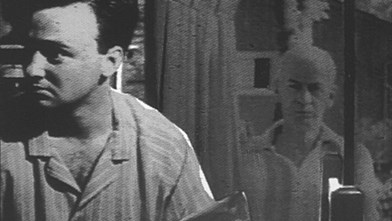
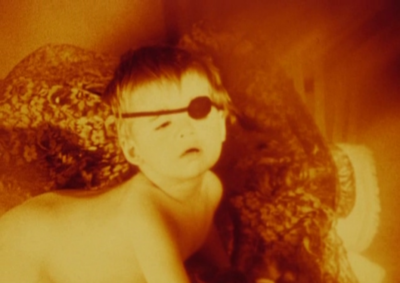





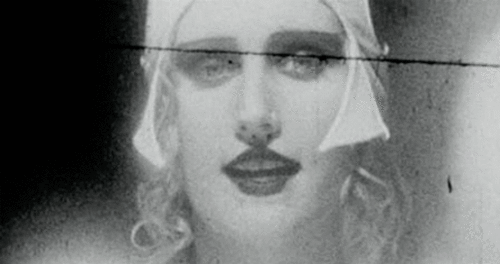
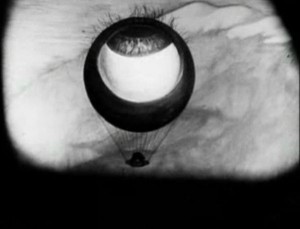
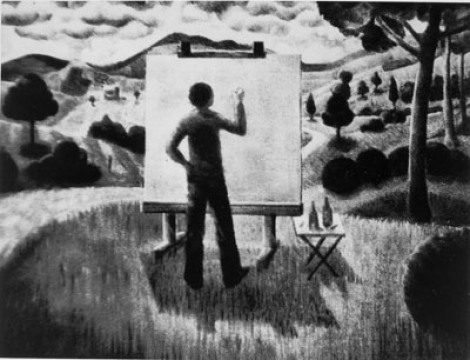

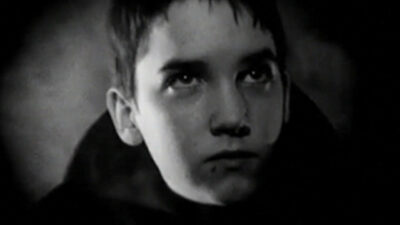
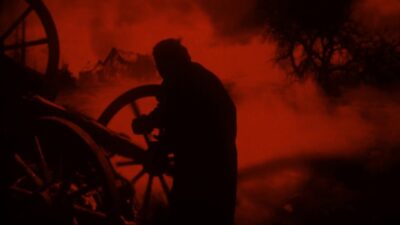
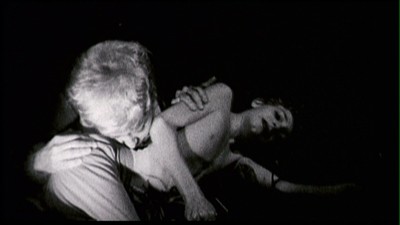
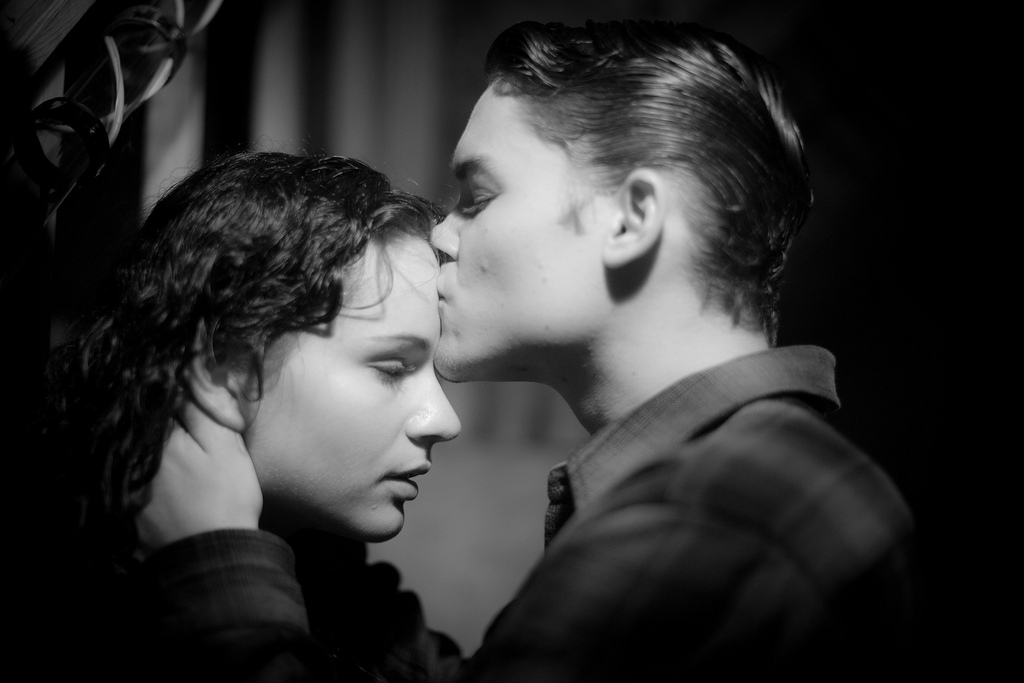
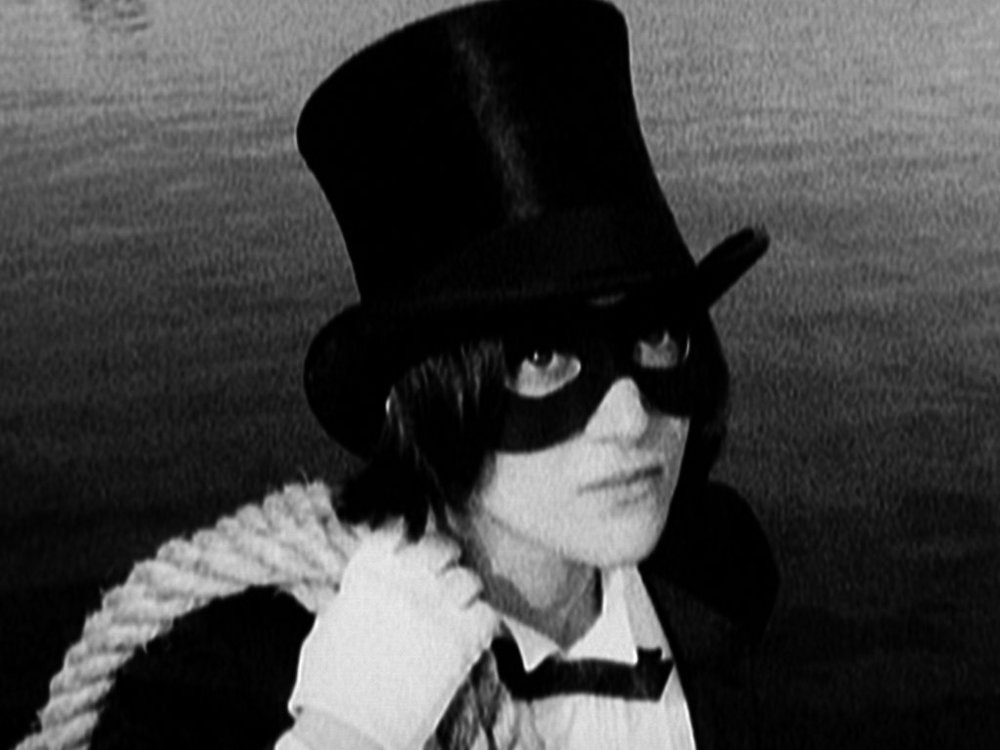
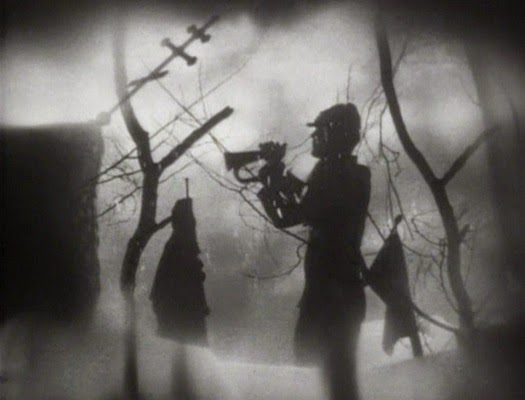
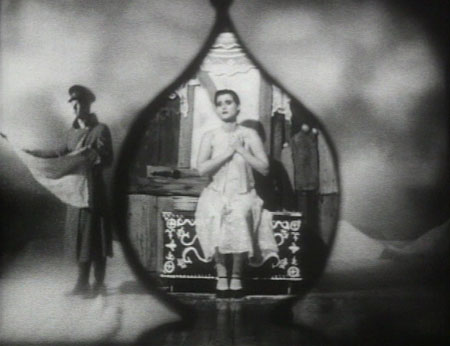
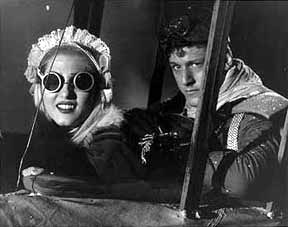
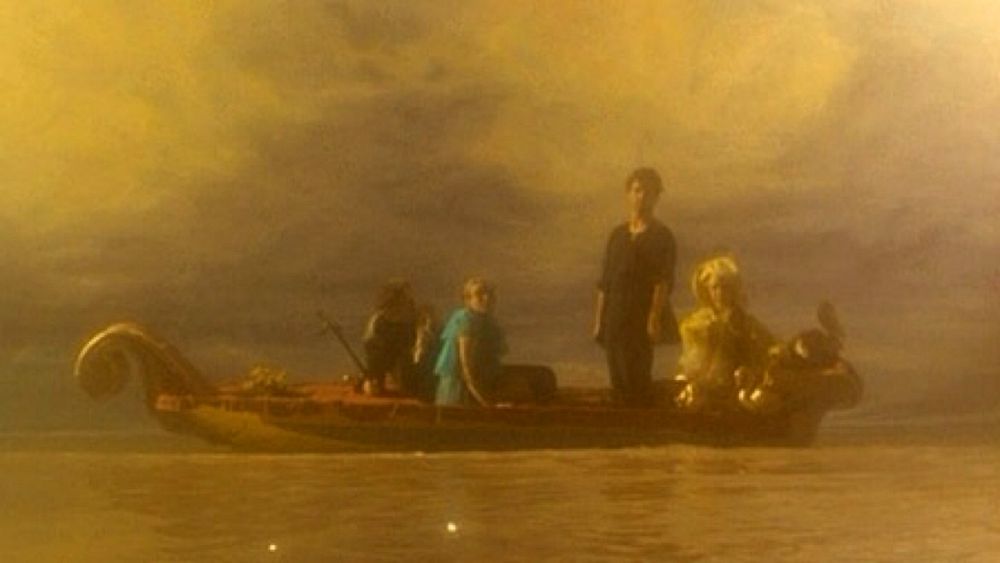
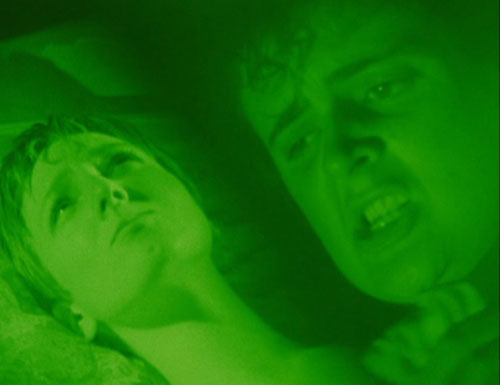
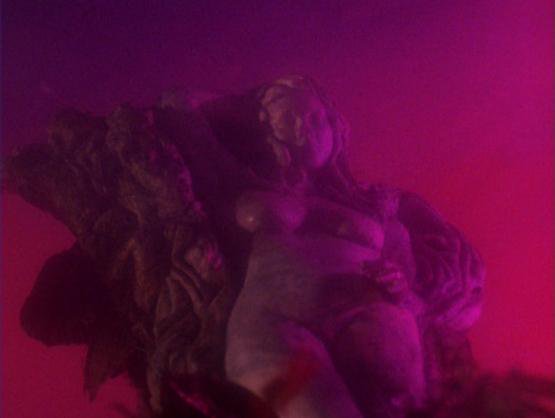
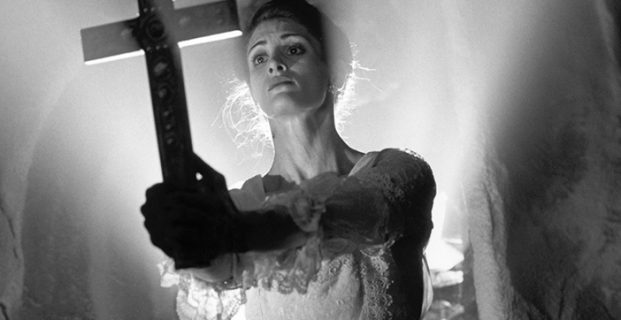
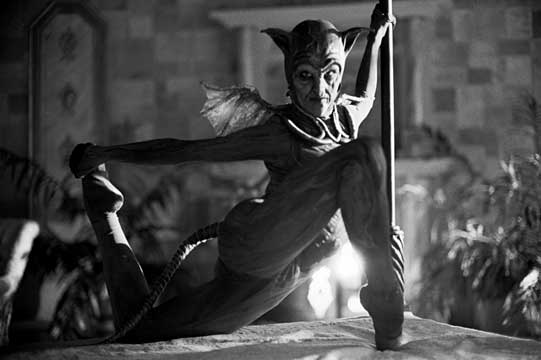
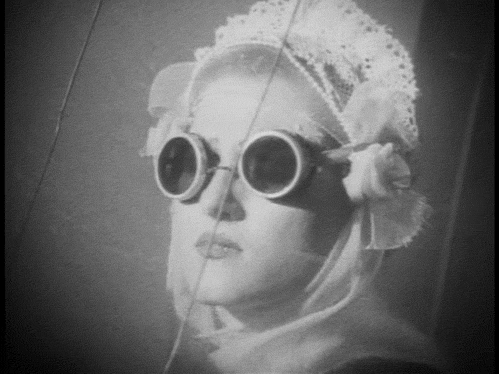


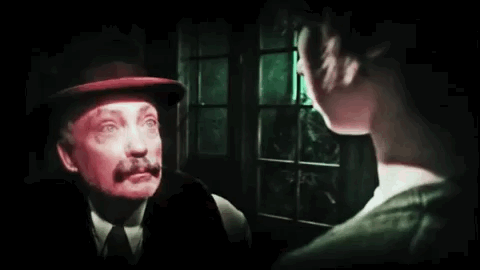


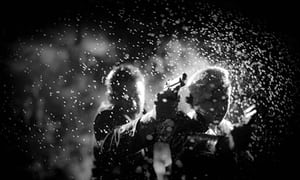
















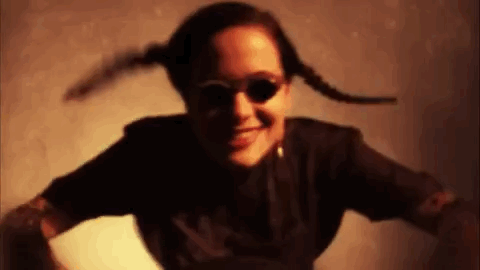



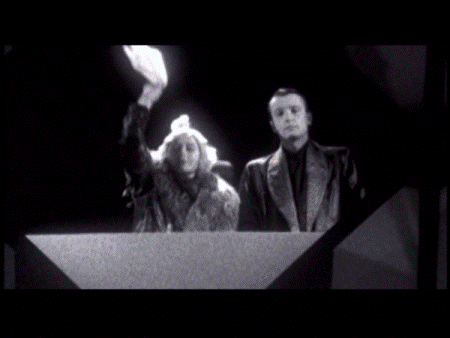






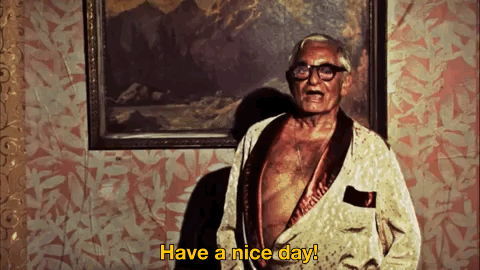
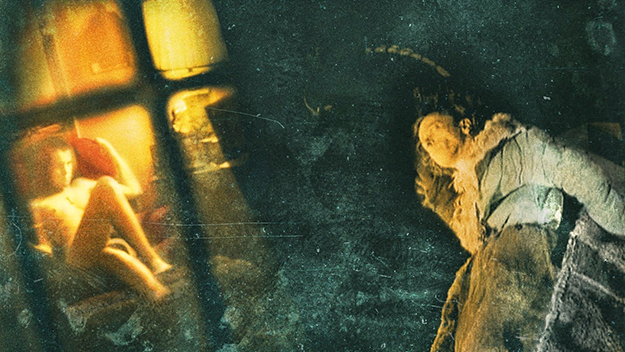
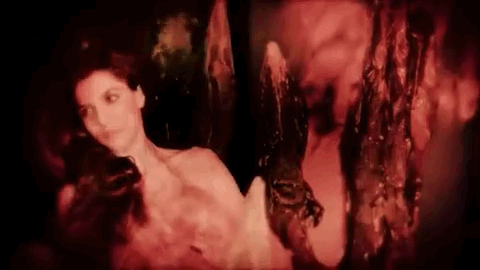

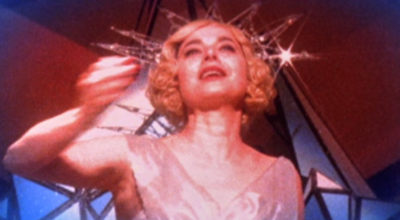
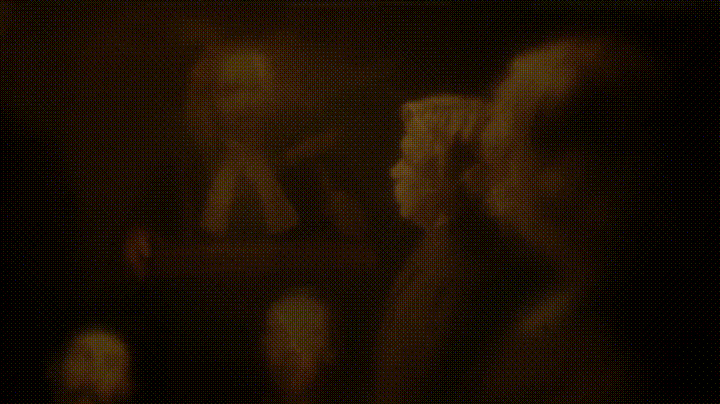

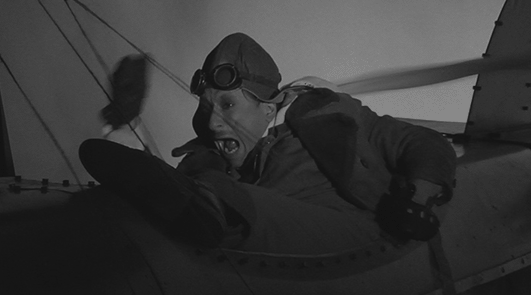
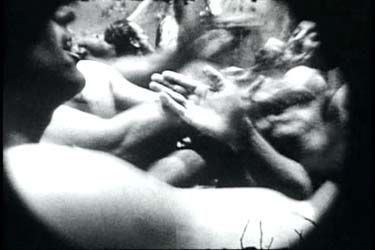

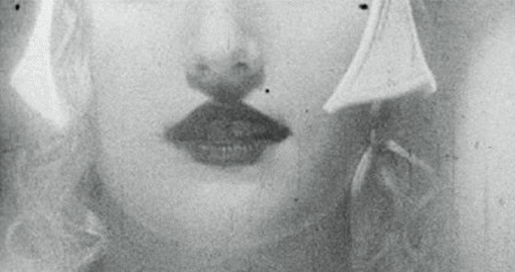


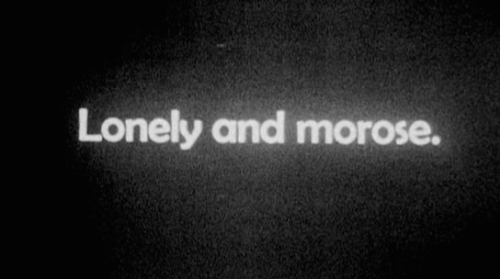






_____
Further
Guy Maddin’s Site
Guy Maddin @ IMDb
Guy Maddin on his surreal seances and sexploitation remakes
‘Vertigo’ Revisited: Guy Maddin Explores Hitchcock’s Classic With Found Footage
Lost in the Funhouse: A Conversation with Guy Maddin and Evan Johnson
THE QUINTESSENTIAL GUY MADDIN
The Sharp Amnesias of Guy Maddin
The Cinema of Guy Maddin
« La Chambre interdite » : les fantômes de Guy Maddin
Guy Maddin on The Saddest Music in The World and His Interactive Seances
Guy Maddin: ‘I wanted to cure myself of myself’
Guy Maddin interviewed @ The Quietus
Guy Maddin Talks About ‘The Artist’ Stealing His Thunder as a Silent Film Director
Guy Maddin interviewed @ The Believer
A Fairy Tale Childhood
Guy Maddin talks about blurring fact, fiction, yesterday, and tomorrow
Monochrome melodramatist Guy Maddin revives himself with a shot of colour
Seances: Guy Maddin’s film generator is an endless cinematic experience
Guy Maddin: The most accessible film avant-gardist
Extending a Sense of Malfunction
From a Safe Distance: Guy Maddin Stills His Lens with Collage
Guy Maddin on Bring Me the Head of Alfredo Garcia
_____
Extras
Guy Maddin Documentary – Waiting for Twilight
Guy Maddin: My Dad is 100 Years Old
Guy Maddin talks about his editing style
Guy Maddin’s DVD Picks
Guy Maddin Interview (Excerpt)
________
Interview

CE: What are the Hauntings?
Guy Maddin: Hauntings are film narratives that haunt me. In most cases, they are films lost to film history. About 80% of all silent films ever made are lost. Films made in the art form’s early years were poorly stored in less than ideal conditions. The years often turned these movies into a vinegar-smelling gelatin. Just as often, silent film product was cleared off a studio’s shelves and destroyed – in staff picnic bonfires or by getting dumped in the ocean – just to make room for the next year’s product. If the films survived either of these fates, a shipping error or projection booth holocaust would consign a print to oblivion. Canonical and not-so-canonical films alike were lost in this fashion. Sometimes a director would go mad and destroy his or her own work, or simply leave it on a subway train or a stranger’s doorstep, abandoned like a baby in a dumpster, vaguely hoping perhaps someone might find it and make a good home for the unwanted thing. No matter how, pictures got lost. These are the film narratives with no known final resting place. They are doomed to wander in limbo over the murkiest landscapes of cinema history, no one ever quite recognizing them, no one ever getting anything more than a fleeting fragmentary glimpse of these sad narratives. They are miserable, haunting… and haunting. These films haunt me because I need to see them and I can’t. Some of these films are by Murnau (who made ten now lost films), Hitchcock, Lang, Warhol, Frampton, Tourneur – even Terrence Malick has a short film – made in his youth – that is only rumored to have been screened. All these titles haunt me.
I figured the only way I could satisfy my compulsion to see these narratives would be to remake them myself. I decided I could invoke them in séance-like conditions produced in a dark studio atmosphere. I could make my own short-film adaptations from synopses or reviews I’d dug up concerning the lost films during nocturnal researches into the subject. My partner Evan Johnson and I dug up over 200 titles of lost films. In addition, I realized that I was also haunted by aborted, mutilated and unrealized movies that cram the bloody margins of film history. Therefore, we included some especially powerful titles that fell under this banner, ones whose non-existence tortured us most. Then we decided to make them all.
CE: In total, how many lost, unrealized and aborted film ideas have you and Evan Johnson uncovered?
GM: We have found exactly 1024. We took that number as a sign to quit looking because there are 1024 megabytes in a gigabyte. That’s got to be good luck!!!
CE: That is clear and precise logic, pure and simple. What are some of your favourite lost, unrealized or aborted films that you have uncovered?
GM: I love Oscar Micheaux, who worked from the late teens till the 40s during last century. He is often described as the black Ed Wood (unfairly, to both Micheaux and Wood). Micheaux would finance his films by selling bibles door-to-door. He would show the films by four-walling them, namely, by renting out space in which to project his films, then he both sold and redeemed tickets himself. He made a living in this fashion and also struggled to get the first films made entirely by African-American producers, writers, crew and actors out into the world. Alas, so many of his titles are gone, probably lost forever. I needed, needed, desperately needed to see these films and finally, sadly, came to the conclusion that in order to see them I would have to remake them myself. Most of his films involved moral conflicts endured by African Americans who can pass for white and therefore were free from racism, but in doing so they always would leave loved ones behind. It is endlessly fascinating and painful stuff. Since I decided that hauntings are race and gender-blind, the stories are reconfigured – by Robert Kotyk, Evan Johnson and myself – so that characters who once passed for white are now passing for something else altogether. I love the sudden elasticity of this metaphor for passing – very Douglas Sirk. I’m not trying to steal the African-American film away from Micheaux and keep them in my greedy white hands; I just want to honour the great man without resorting to literal imitation while exploring the possible stretch quotient of his plots and metaphors. I think Douglas Sirk was already onto this idea that everyone passes, or attempts to pass, in his Imitation of Life (1959). Utterly fascinating!
CE: Although I don’t feel this question is really relevant in 2011, I’m sure there is at least one film student or bureaucratic minded reader who is just dying to know, do you think there will be any rights issues?
GM: No, not really.
CE: Speaking of asking for permission, did John Waters ever give you permission to make any of his lost, unrealized or aborted films. I would love to see Water’s aborted Dorothy, The Kansas City Pothead!
GM: No, and he kept evading the issue when I brought it up over and over during my Border Crossings interview with him. He’s slippery that way. I don’t blame him for not wanting another director to make his unrealized or lost pictures, especially if that filmmaker is me! I don’t want to mess with any living directors anyway. They have feelings, they’re much more easily hurt than the dead.
CE: On that note, although you are paying homage to the original directors, you are still altering their intended vision. Do you feel that the original directors may be haunted by your version of their film?
GM: I don’t believe in ghosts normally, but when I hold a camera in my hands I do. I hope my re-filming of their work disturbs them, however, I’m merely paying homage to a dead spirit, through an act of fraudulence, through a mountebank’s séance, by invoking an artificial facsimile of that dead object. I’m as big of a charlatan as the most crooked medium who ever duped a grieving relative. Winnipeg’s famous dabbler in the occult, Dr. Hamilton, started out trying to contact his dead son. Somewhere he quit trying to do that and instead turned all his energies to fooling or enchanting others. The séance reminds me of filmmaking in that respect. Genuine emotions can be sought and earned even though the work of a charlatan. We all know that film is an artifact of artifice, a species of a lie.
CE: Given that filmmakers are prone to deceiving, have you stumbled across any filmography padding?
GM: Some people think that Hollis Frampton never made Clouds Like White Sheep (1962) and that he just made up both its existence and its loss on that NY streetcar. I chose to reshoot it anyway since I am just as haunted by its possible existence as I am by its possible loss.
CE: I even conjecture that some supposedly lost films are actually not in fact lost. For instance, I recently uncovered a few of James Benning’s erotic films that are considered “lost”, namely Gleem (1974) and An Erotic Film (1975). Since these are the only films in his entire filmography – in addition to 57 (1973) – that have been lost, something tells me this was intentional. Have you ever wanted to lose any of your films?
GM: I have lost a few of my films. I melted the only tape of my 1995 TV exercise The Hands of Ida at a picnic. Too bad, it had a few good friends in it, but I needed to destroy it in a black magic ceremony because this was the first film I made strictly for money ($5000), and the first film I made with producer Ritchard Findlay. This film triggered the first profound depression of my life – all these damned good reasons for throwing the cassette into Satan’s flaming asshole. I had a great time making the movie, but all too often one has a great time doing business with Satan. Twilight of the Ice Nymphs (1997) should really be lost as well, although I am happy to have met two great characters while working on it – Shelley Duvall and Frank Gorshin. If I had made a play with them instead I still could have gotten to know them and there would be no aide memoire linking me to such a terrible time.
CE: Twilight is easily my least favourite of your work, however, it might have actually worked better as a play. On the other hand, The Heart of the World (2000) is my favourite of your films, in fact, it is easily one of my favourite films. Wasn’t Heart of the World a partially realized Abel Gance film? Have you found any of his other lost films?
GM: Yes. Making Heart of the World was my way of seeing the partially lost Gance film La Fin du monde (1931). It exists in highly mutilated form. Also, my short film Odilon Redon (1995) was my attempt at remaking what I thought was a lost Gance film, La roue (1923). I later found out that the film was never actually lost, it just wasn’t available on VHS. Gance has a number of lost films and a number of unrealized projects since he was considered far too mad to trust with money, so his grandest visions went unrealized.
CE: Who will be acting in the Hauntings?
GM: I’m hoping to get a rep company of actors in each city. In Paris, I’ll have 20 French actors, plus Louis Negin. In NY, I’ll have 20 New Yorkers, plus Udo Kier! I will cast these people out of my pool of FaceBook friends. I hate headshots, but I love FB photo albums. One can learn a lot about a way a person will look on film by looking through thousands of snaps taken during drunken frat parties.
CE: Are you still using Sparks in a Haunting?
GM: Ron and Russell Mael – the brothers who make up the pop group Sparks – were been hand picked by Jacques Tati to replace the Hulot character played for so many years by Tati himself. Hulot was to be killed off in a film called Confusion, and the Maels were to run a TV station in the manner of Hulot. Negotiations between Tati and Maels reached the point of press conferences and then suddenly Tati died and the project was aborted. The Maels describe this cancellation as the biggest disappointment of their lives. I’d feel the same. I thought it would be great to invoke the spirit of the Tati, but not the litigious script written by the master himself, and set a little fragmentary story in a TV station and star the Maels in it. My director of photography Ben Kasulke has already shot the Mael portions of the movie. Look for them on TV monitors in the shot-in-Winnipeg tribute!
CE: The Hauntings were originally intended to be directed by emerging directors in a Warhol-esque factory setting in Winnipeg. Is this still happening?
GM: No. But you’re right that my original intention was to make 130 of these things in a big communal and Utopian factory set-up, whereby deputized filmmakers would be shooting the bulk of the films under strict orders to obey my precise list of style commandments. I embarked on this mad enterprise in the summer of 2010 when I was also shooting my feature film Keyhole (2011). I felt the two projects, Keyhole and the Hauntings, were one and the same project. There were aesthetic reasons for making the two massive projects simultaneously. It was a mad, mad, madly naïve idea of mine that five or six handpicked filmmaking colleagues could make twelve films a day after a mere one hour drill on the six basic points of my visual manifesto. Perhaps I was self-destructive, eventually I awoke to the damage I was doing to the Hauntings by spreading my attentions so thin. I suspended the reshooting of these precious lost films until a time in the future when I’d be more ready for the campaign.
CE: What is happening with what has already been shot?
GM: Well, my editor John Gurdebeke cut 11 of them into little installations designed to haunt the new Bell Lightbox building that TIFF just built for its wonderful festival. I convinced Noah Cowan, the building’s director, that the space was far too new to show films in, and that it needed to be spooked with restless spirits from the musty pasts of film history. He agreed and paid me a nice big commission. I ended up by giving him 11 Hauntings to project during that building’s first few months. Now the place already feels lived in, a bit more mysterious than it would have been otherwise. The 30 other films that were reshot in 2010 remain in storage. I have no definite plans for them. I might lose them on purpose, or abort work on them, thus producing a double haunting – an aborted aborted film, a lost lost film or unrealized unrealized.
Either way, I’m going to start over completely and reshoot everything that was already reshot in 2010. In some cases, there will be many different, reconfigured versions of a lost film. It has been our plan all along to shoot alternate versions of each movie, as if its spirit couldn’t quite remember what form it should take. In other cases, the lost films had many different versions in the first place. For instance, Murnau’s most famous lost film, 4 Devils (1928), had four different endings shot – a different character killed in each denouement. We’ve already shot a different 4 Devils, and now as I am reminded of that wonderful story, I think I’ll double or triple the variations. I don’t think any medium has every guaranteed a crystal clear communication with a dead beloved, why should my precious lost films be literally the same in the afterworld as they were on earth?
______________
24 of Guy Maddin’s 69 films
______________
The Dead Father (1985)
‘Guy Maddin’s The Dead Father is a superb short film and his first. In only twenty-six minutes, it etches a portrait of familial strife and neurotic obsession that’s as poignant as incisive as any that cinema has to offer outside of Bergman. That flattering description doesn’t exactly do the film justice, however, since it neglects to mention the stylistic adventurousness and quirky sensibilities that are found here. Shot in black-and-white, the movie feels like a low budget 50’s era melodrama, complete with minor technical imperfections. The quality of the picture has been artificially degraded, and the sound fades in and out, demonstrating an analogue uncertainty. The effect of these stagy flaws becomes startlingly emotional when the subject matter of the movie is considered. The film’s unnamed protagonist (designated only as “The Son”) narrates the film, reminiscing about his deceased father, who wouldn’t quite stay dead when he was supposed to. Like the work of fellow surrealist David Lynch, Maddin encapsulates the overbearing presence of the father figure by loading the screen with 50’s nostalgia. Since the oppressors (fathers) believed in the power of 50’s melodrama to provoke emotion and the power of a peanut butter and jelly sandwich to nourish, their presence here next to the beleaguered son seems downright ominous. More than most filmmakers, Maddin has the ability to recognize the archetypes of cinema and pop culture, and then turn them upside down and against us in a pointed attack.’ — Movie Martyr
Excerpt
Excerpt
______________
Tales from the Gimli Hospital (1988)
‘Guy Maddin’s outrageously bizarre debut was one of the big hits of the 1980s midnight movie circuit. Reckless envy, unconsummated passions and necrophilia set the tone for these surreal tales shared by two patients confined during a turn-of-the-century smallpox epidemic.’ — Zeitgeist Films
Excerpt
Excerpt
_______________
Archangel (1990)
‘Deep in Russian snows, peg-leg Canadian soldier Boles, pining for his lost Iris, is billeted in Archangel with the family of the lovely Danchuk; but the addled Boles ignores Danchuk’s feelings for him in favour of mysterious Veronkha, whom he mistakes for Iris, although she is really the spurned wife of a faithless Belgian aviator… Confused? No matter; so are the characters in this absurdist melodrama. Maddin’s second feature is pitched straighter than Tales from the Gimli Hospital, but is every bit as inspired and patchy. Pastiche remains to the fore, with Maddin’s acute sense of camp more historically motivated than before. Complete with hieratic ’20s-style acting, the film is an extravagant mélange of All Quiet on the Western Front, Eisenstein and DeMille, all the more impressive for its cut-price mise en scène. The war scenes are extraordinary, although thrown in far too liberally; even better are the daft tableaux vivants which seem to comprise Archangel’s only entertainment.’ — Time Out
Excerpt
Excerpt
____________
Careful (1992)
‘Guy Maddin’s early masterpiece takes place in a 19th-century Alpine village where the wary residents —adult, child and animal!—must speak softly and tread lightly lest they cause an avalanche. But sexual frenzies teem in this world of repression, setting off incestuous love triangles and quadrangles with deadly consequences. Bathed in lurid, luminescent tints, Careful resembles a vintage melodrama from another planet—something that could only emerge from the singular mind of Maddin.’ — Zeitgeist Films
Excerpt
Excerpt
_______________
Odilon Redon or The Eye Like a Strange Balloon Mounts Toward Infinity (1995)
‘Weird and wonderful oddity from remarkable Canadian auteur Guy Maddin which, at six minutes, lasts only slightly longer than it takes to say the title. It refers to a little-known 19th-century French surrealist painter and one of his works. Maddin uses the painting as inspiration for a strange fantasy about father-and-son rivalry over the affections of an underwater train-crash survivor. He uses his trademark distressed film stock and silent cinema pastiche to mess with your head even more.’ — Metro.co.uk
the entire film
________________
The Hands of Ida (1995)
‘Hands of Ida is a half-hour TV drama which Maddin directed for hire and is probably the worst thing he ever made. In revenge for the rape and murder of a girl named Ida, a group of radical women go about surgically castrating randomly kidnapped men. A bickering pair of former lovers who work for a market research company conduct an implausible opinion survey to find out how people feel about what’s going on. The script is ridiculous and the acting amateurish in what is, to date, Maddin’s only attempt at a contemporary story set in the supposedly “real” world.’ — mr_avid
Excerpt
_______________
Twilight of the Ice Nymphs (1997)
‘Twilight of the Ice Nymphs is the dream-struck fantasia of Peter Glahn, a political prisoner returning after several hard years of incarceration, to his homeland of Mandragora where the sun never sets. While traveling by boat, he spends a few precious minutes in the enticing and rarefied company of Juliana (Pascale Bussières), a beauteous young woman with whom he falls desperately and immediately in love. He disembarks to find a veritable ronde of romance brewing in the smouldering passions of sun addled Mandragora: his ostrich-farming sister Amelia (Shelley Duvall) is sick with heartache for the mesmerist Dr. Solti (R.H. Thomson), who with a greedy and voluminous passion, seeks the favours of both Zephyr (Alice Krige), a fishermans widow now married to the forest, and the statue of Venus recently uncovered and mounted imperiously on a hilltop. Zephyr gives herself to Peter upon his arrival, but he can think of no other than Juliana and her strange connection to the haughty Dr. Solti. Amelia, driven to distraction by her unrequited passion for the Doctor as well as by the unwelcome attentions and misguided vengeance of her handyman, Cain Ball (Frank Gorshin), loses her reason and spirals into homicidal madness, gravely injuring Cain. Peter is also maddened by his unrequited love for Juliana and the way in which it is constantly thwarted by the wily Doctor, and so the story goes
.’ — Winnipeg Film Group
the entire film
_______________
The Heart of the World (2000)
‘Maddin pulls out all the stops in this dreamlike, hyperkinetic tribute to silent films. ‘The Heart of the World” could easily have been a throwaway film, given the circumstance of its origin. The Toronto Film Festival commissioned Maddin to make a brief film to fill a gap in their programming schedule. A mere time-passer. What Maddin gave them was utterly unexpected. Maddin uses large-grain film stock and Klieg-style lighting techniques to replicate the look of silent film. Maddin’s production design (costumes, makeup, hairstyling) impeccably recreates the images of that period. It’s easy to believe that ‘Heart of the World’ is actually compiled from old UFA out-takes, circa 1925. Only just occasionally does Maddin’s grasp on the 1920s show the joins, and then those lapses are probably intentional. ‘The Hearts of the World’ depicts the rivalry of two brothers. Nikolai is an idealist engineer. Osip is playing Jesus Christ in a passion play, and seems to have developed a genuine messiah complex. Amusingly, Osip does his Jesus routine whilst toting a cross made from metal girders … an Art Deco crucifixion!’ — Shorts Bay
the entire film
_______________
Hospital Fragment (2000)
‘The attempts of a young man (Neale) to consummate his love for a young woman (Heck) are thwarted by a fish monger (Fehr). The woman’s beloved (Gottli) cuts bark fish.’ — Winnipeg Film Group
the entire film
_________________
Dracula, Pages Tirées Du Journal D’Une Vierge (2002)
‘After garnering widespread acclaim with his mini-masterpiece THE HEART OF THE WORLD, Canadian cult auteur Guy Maddin concocted his most ravishingly stylized cinematic creation to date. Beautifully transposing the Royal Winnipeg Ballet’s interpretation of Bram Stoker’s classic vampire yarn from stage to screen, Maddin has forged a sumptuous, erotically charged feast of dance, drama and shadow. The black-and-white, blood-red-punctured DRACULA: PAGES FROM A VIRGIN’S DIARY is a Gothic grand guignol of the notorious Count and his bodice-ripped victims, fringed with the expressionistic strains of Gustav Mahler.’ — Fandor
the entire film
________________
Fancy, Fancy Being Rich (2002)
‘Silent, surreal short about drunk sailors hunting women, based on a kitsch opera aria.’ — iffr
the entire film
________________
Cowards Bend the Knee (2003)
‘According to the feverish dream logic of the very first shot of the faux-silent film Cowards Bend the Knee, an insidiously entertaining bit of whimsy courtesy of Guy Maddin, all of life’s melodrama can be found within a single drop of sperm, so wash those cum rags at your own aesthetic risk. Cowards might not be the first time Maddin, Canada’s own titan of twee avant garde cinema, has focused his vision down to its most basic elements. (Most seem to agree that his five-minute The Heart of the World is his masterpiece.) But it is undeniably a much purer representation of his “devil may care” approach to film form than his other, more widely distributed recent film, the amusing but narratively overbaked The Saddest Music in the World. And it’s more insane.’ — Slant Magazine
Trailer
the entire film
_________________
The Saddest Music in the World (2003)
‘The more films you have seen, the more you may love “The Saddest Music in the World.” It plays like satirical nostalgia for a past that never existed. The actors bring that kind of earnestness to it that seems peculiar to supercharged melodrama. You can never catch them grinning, although great is the joy of Lady Port-Huntly when she poses with her sexy new beer-filled glass legs. Nor can you catch Maddin condescending to his characters; he takes them as seriously as he possibly can, considering that they occupy a mad, strange, gloomy, absurd comedy. To see this film, to enter the world of Guy Maddin, is to understand how a film can be created entirely by its style, and how its style can create a world that never existed before, and lure us, at first bemused and then astonished, into it.’ — Roger Ebert
Trailer
Excerpt
_________________
A Trip To The Orphanage (2004)
‘While an opera singers sings in a snowy and cold street, we are allowed to witness a meeting between a man and a woman through blowing net curtains. The music is touched by sadness and the emotions of the characters are no different. Nearer they become while the singer sinks deeper into the melancholy.’ — letterboxd
the entire film
_________________
Sombra dolorosa (2004)
‘“Sombra Dolorosa” returns us to more familiarly comic Maddin territory, with a deranged plot, hysterical intertitles (“to save your daughter you must defeat… El Muerto!!”), and the same psychotic editing that characterized Cowards Bend The Knee. It tells the story of a bereaved widow who must defeat death in a wrestling match, before an eclipse arrives, in order to save her daughter from suicide (“FROM SUICIDE!”, the titles remind us). After bodyslaming El Muerto into submission, however, the rules suddenly change. Now, Death must eat her husband’s corpse before the sun comes up, or he’s forever lost! Meanwhile, inconsolate daughter Delores decides to kill herself anyway by throwing herself into a river, but a good Samaritan saves her. It all ends happily (?) with the father’s ghost entering a mule to wander the world.’ — 366 Weird Movies
the entire film
________________
Sissy-Boy Slap-Party (2004)
‘I made this film as part of a teaser campaign to help promote The Saddest Music in the World. I like to think it merely promoted more slapping. Inspiration for the title came from my friend, the author and actor Caelum Vatnsdal, who described to me Sissy-Boy Slap-Party as a game he played frequently with great pleasure and large quantities of salty tears. I kept him on set as a technical consultant to make sure my interpretation of this sport matched his own.’ — Guy Maddin
the entire film
________________
Brand Upon the Brain! A Remembrance in 12 Chapters (2006)
‘In the weird and wonderful supercinematic world of Canadian cult filmmaker Guy Maddin, personal memory collides with movie lore for a radical sensory overload. This eerie excursion into the Gothic recesses of Maddin’s mad, imaginary childhood is a silent, black-and-white comic science-fiction nightmare set in a lighthouse on grim Black Notch Island, where fictional protagonist Guy Maddin was raised by an ironfisted, puritanical mother. Originally mounted as a theatrical event (accompanied by live orchestra, Foley artists, and assorted narrators), Brand upon the Brain! is an irreverent, delirious trip into the mind of one of current cinema’s true eccentrics.’ — The Criterion Collection
Trailer
_____________
Footsteps (2008)
‘Short documentary revealing how the sound effects were created for Maddin’s film “Brand Upon the Brain”.’ — Letterboxd
the entire film
__________
Keyhole (2012)
‘Keyhole situates itself in the heart of that unconscious where all events are simultaneous and death is never more than a distant rumor. There is less distancing here; the sense of constant and overwhelming incongruity is less comic than mournfully unsettling. We are in some kind of horror movie, or a mash-up of horror movies, as if Carnival of Souls, The Exterminating Angel, A Page of Madness, Castle of Blood, The Invisible Ray, Vampyr, and assorted episodes of The Whistler had all been thrown in the blender. Everything here—dissolves, blurs, superimpositions, harsh lighting contrasts, along with the B-movie poetry of Maddin and George Toles’s screenplay—says to be afraid. Everything is a cue calculated to terrify an unwary 3-year-old. The action is nominally centered on some gangsters holed up with their hostages in a house under siege. The living are to be separated from the dead, but one way or another they’re all dead, ghost outlaws holding ghost hostages and themselves held hostage by the house’s resident ghosts, a maid eternally down on her hands and knees scrubbing the floor, a naked old man shackled to a bed (Louis Negin) who also provides a constant voiceover wail of fragmentary revelations.’ — Film Comment
Excerpt
Excerpt
__________________
The Forbidden Room (2015)
‘Guy Maddin’s latest creation begins with a bath—and continues as a bath, an immersive plunge into the roiling waters of cinema’s history and its unconscious. Note that I didn’t call The Forbidden Room Maddin’s “latest film,” for this isn’t so much a film as an encyclopedic compendium of cinematic possibilities, a cauldron bubbling over with highly spiced visual and narrative tropes. No apologies for the hyperbolic tone of the above: to wax over-lyrical is simply to enter into the florid, wildly heated spirit of The Forbidden Room. Credited to Maddin as director and Evan Johnson as co-director, this 119-minute marvel is a genuinely experimental experience, at once an imagistic neo-“happening,” a cornucopian overflowing of story, and a materialist rhapsody on the textures of antique film stock—albeit one that happens to have been created 100 percent digitally. The Forbidden Room might be described as a kind of deconstructed portmanteau movie, with its torrential flow of tenuously linked episodes and fragments. The film begins with a portly, avuncular roué (long-standing Maddin regular Louis Negin) saucily discoursing to camera on the best way to take a bath. When you soap yourself, he advises, start at the armpits and work down to the genital area: “Work carefully in ever-widening circles.” The film too proceeds in widening or possibly ever-narrowing circles, following a concentric structure of tales within tales. The bathwater leads—free-associatively, it seems—to another kind of tub, a submarine. Perhaps the sub is present as a microscopic toy within the bathwater, just as the events in Maddin’s faux-autobiographical melodrama Cowards Bend the Knee (03) apparently take place in a drop of sperm viewed through a microscope in the opening sequence.’ — Film Comment
Trailer
___________
Seances (2016)
‘Seances presents a new way of experiencing film narrative, framed through the lens of loss. In a technical feat of data-driven cinematic storytelling, films are dynamically assembled in never-to-be-repeated configurations. Alongside other audience members, glide your hands over a screen filled with images, titles, and descriptions, each of which is connected to a unique scene. This is your opportunity to influence what you’re about to see, and the only time the film you create will ever exist. There is only this moment in which to watch it. Seances is the brainchild of award-winning Winnipeg filmmaker Guy Maddin, one of the world’s foremost outré directors. Long haunted by the idea that 80 percent of films from the silent era are lost, Maddin and brothers Evan and Galen Johnson have re-imagined many of these old movies with the express goal of combining and recombining them to create infinite narrative permutations.’ — NACC
Trailer
_____________
w/ Evan and Galen Johnson The Green Fog (2017)
‘“The Green Fog, created by filmmaker/cultural iconoclast Guy Maddin with co-directors Evan Johnson and Galen Johnson, with composer Jacob Garchik and Kronos Quartet, pays homage to Alfred Hitchcock’s spellbinding Vertigo. Inventive and invigorating, this ‘San Francisco Fantasia’ is lauded by the New York Times as ‘a marvel of film scholarship.’ It’s also a lot of fun. Maddin, working with his Forbidden Room collaborators, set himself the challenge to remake Vertigowithout using footage from the Hitchcock classic, creating a ‘parallel-universe version,’ in his words. Using Bay Area footage from a variety of sources—studio classics, ‘50s noir, experimental films, and ‘70s prime-time TV—and employing Maddin’s mastery of assemblage, the result exerts the inexorable pull of Hitchcock’s tale of erotic obsession while paying tribute to the city of San Francisco.”’ — Balcony Film
the entire film
_____________
w/ Evan and Galen Johnson Stump the Guesser (2020)
‘He works at the fairground as “Stump the Guesser”, who can guess anything for a fee. But suddenly his tricks stop working. Then, he falls in love with his sister whom he believed to be lost. He sets out to scientifically disprove the theory of heredity and marry his beloved as soon as possible.’ — IMDb
the entire film
_____________
Haunted Hotel – A Melodrama in Augmented Reality (2022)
‘With his avant-garde style, Guy Maddin delicately envelops his audience in surreal paper worlds, exploring the hidden layers of human nature. Embracing an eclectic selection of clippings from his personal archive, Maddin’s Hotel hosts familiar pop culture figures alongside ecstatic 1960s nudists and frightened film noir actors. Find out what’s stirring behind closed doors via virtual peep holes and leaf through rooms filled with longing, hysteria and madness, all set to an intricate soundscape by acclaimed composer Magnus Fiennes. Premiering in the BFI London Film Festival Expanded programme, this is Guy Maddin’s first immersive project.’ — BFI
Trailer
*
p.s. Hey. ** Dominik, Hi!!! Happy After. The cicadas-looking ones are insane. Only two left now. No!!!! I should really try ‘Dragula’ since I don’t watch drag shows, and I should, and a horror-themed drag show is as tempting as it’s going to get, I think. So what did you do last night, if anything? I just did the Zooms as predicted. Nothing exciting to report there. I would like to ask love what Tina Turner Burner means exactly, because I thought and thought and could not for the life of me figure out what that meant. Love answering my question and also watering the poor, dying plants on my neighbor’s windowsill or giving me a water pistol so I can try to do it from my window, G. ** SP, Hi, SP. Cool, thanks for coming back. Wow, you have a lot of jobs, but you live in the NYC environs, so I guess that’s necessary. Yes, a turkey leg in every hand, ha ha, it’s true. When you say your art, what do you mean or what’s your art? Only if you feel like describing. In any case, happy Halloween aftermath and good luck with the psycho. ** John Newton, Hi, John, Good to see you. Happy belated Halloween to you. So far my chocolates are delicious, thank you. Eek, glad your cat’s back to regular. Did you get a lot of trick or treaters? I obviously got zero. Oh, I watched a terrible in retrospect horror movie called ‘The Mad Doctor’ on TV when I was a little kid that scared me shitless. I’m rather hard to scare post-childhood. The only horror movie that did as far as I can remember was ‘Blair Witch Project’ when it first came out. Freaked me out. Thanks for the funds luck, we really need it. Best of the best to you, sir. ** _Black_Acrylic, Same back to you from the future! Now, your mom is a very good mom. ** Steve Erickson, Hi. Ha ha, no, if only. It was recorder consorts playing Giovanni Pierluigi da Palestrina ditties for as far as the ear could hear. A couch nice. How did it/he look? Oh, man, so sorry about the MRI option/payment. At least you feel better, so high hopes. ** politekid, Hi, O! Happy last night to you too! Your Halloween created a sufficiently Halloween-like world within my mind that I almost feel like I should have a Halloween hangover, thank you, I needed that. The pumpkins were especially potent. The Zoom meeting did not seem to zoom anything we need into focus, alas, but a big American indie film producer loves our film, and we’ll see if that means anything. You good in general? How’s stuff. How’s you? ** MIKA, Hi! Thank you. You published a book with Apocalypse Party! Awesome, that’s one of my very favorite presses. I’ll go get it. Great, congrats to them and to you. And I’ll hit those links, of course. Thanks a lot! I really forward to getting to know your stuff. ** Marc Vallée, HI, Marc. How’s it going? If I’m Paris on the 10th, which is a little doubtful at the moment, I’ll try to make it. Thanks. Nice that it’s happening. Everyone, If you’re in Paris on Nov. 10th, the fine photographer Marc Vallée is launching his new book at Librairie Sans Titre in the 11th on Nov. 10. Details here. ** alex, Hi, alex! Good to see you, pal. Time reversed Happy Halloween to you! That mites story made my skin get all goosebumpy thus making it feel a little more like Halloween actually happened here in the Paris desert. Yikes. Obviously happy that the prose poem is in action. I just did a few Zoom meetings on Halloween. There’s no Halloween here. The French don’t get it. It’s bewildering. Thanks for getting to ‘God Jr.’. The game in the novel is totally invented. However, there were a couple of old Nintendo 64 games that influenced it: ‘Banjo Kazooie’ and ‘Conker’s Bad Fur Day’. Thank for the kind words, man. And for the luck on the film funding. We’ll find it because we have no choice, but hopefully as soon and as non-torturously as possible. Take care. Keep me up on you when you can. ** Darbivelociraptor 🦖 ( not a raptor), Hi, Not a raptor, whew. I do believe my eyes widened just a little bit at the BOOO!! so I would say it was victorious because I’m very hard to scare. Thanks about the photos. Clown cat has a nice conceptual effect. Very big luck with your drivers licence test! That would be great. For me, they made you drive actual cars in actual places, and … I think I just squeaked by if I’m remembering right. I remember the written exam part was a lot harder. I do know about that California car chase guy, yeah, although I hadn’t remembered him in years. I’m ok. I’m going back to full time editing the film today because we have to finish it very soon. I never liked Marilyn Manson. I always thought his thing was simplistic and overly calculated. Dude, you’re mega-smart. You have a unique voice, and unique voices are the best thing ever, and having one was my goal when I started writing, so you’re more than smart/cool. ** malcolm, Hey. Happy Halloween in repose! Oh, very nice. You were Cecil B. Demented to the T. I should send that link to John (Waters). He’s a friend. Can I? May our Novembers slay! ** Bill, I was hoping that would be the case. Earthquake! A lot of them over there lately, no? Or maybe not. I’m fine. No Halloween, but what’s done is done and all of that. ** Audrey, Hi, Audrey. Thanks for pausing. I appreciate it. That Todd Verow film is awful. It soured me on letting people turn my books into films. Other than a number of short films by young and student filmmakers, I usually say no. My novel ‘God Jr.’ almost became a film because I liked the director’s ideas, but he wanted to do it with animation mixed with live action, and it ended ups being too expensive to finance, alas. Twizzlers are good. Ooh, now I want some, I doubt they’ll them over here, but … hm. I hope your marathon completely fulfilled your Halloween longings. All the ultra-best as November kicks off. Love, Dennis. ** Corey Heiferman, Ha ha, yeah, I would certainly stand out as Renaissance slave. Never seen one. Maybe I should make a slave profile using old Renaissance Faire photos, but I fear they’re too yellowed to fool any Masters. Cool about the BDSM club. Do recount your adventures, well, you know, if you care to. I’ve had one chunk of the avocado chocolate. I chewed and chewed, tasting nothing but chocolate therein, and then swallowed, and then I concentrated and maybe just maybe tasted the teeny tiniest flavour of avocado somewhere in the after taste. In other words, no, it doesn’t. ** Right. I really like Guy Maddin’s films, which caused me to go find the blog’s old Guy Maddin post and restore, update, and expand it for your hopeful viewing pleasure. See you tomorrow.




 Now available in North America
Now available in North America 
That’s cool Dennis, hope to see you and thank you for the mention 🙂 Marc x
Hi!!
I can only recommend “Dragula.” In the end, Anita managed to cut her meeting with the ex-colleague short enough that we could watch the season-opening episode, and it was pretty good. There’re a few contestants I’m really excited about.
If love tells you what “Tina Turner Burner” means, please share the wisdom. I have no idea either and would really like to know, haha.
Oh. Poor plants. For some reason, I always take it hard when people ignore or hurt plants, especially trees. Maybe because they seem even more vulnerable than animals – they can’t even move around to take care of or protect themselves. I hope they won’t let them die. Or that you get a water pistol.
Love charming the box of the cicada-looking chocolates so that it always refills itself as soon as you eat the last piece, Od.
Guy Maddin films are pretty easy to locate, so I’ve added a couple to my DVD list. My Winnipeg and Keyhole ought to get me started.
Happily enough, I’ve done the final bit of homework for the Flash Fiction course tomorrow and I’m really thrilled about it! Tasked with writing something influenced by memoir, The Good Boy is about being granted superpowers by God and picking up the school. So it’s been a good day.
Great to see the expansion of the Maddin day! My favorites are probably Careful and Saddest Music in the World. Though not surprisingly I have a soft spot for Sissy Boys. I’ve never seen Heart of the World, will get to it ASAP. Also have good memories of My Winnipeg, which is not included here. Not one of your favorites?
There’ve been a few earthquakes in the area, though nothing major. But we get them all the time, people here are pretty blasé. Great for tourists though! New York gives tourists celebrity encounters, San Francisco goes for earthquakes. (Last time I was in NYC, this guy came up to compliment my Psychic TV shirt; turned out to be Genesis P-Orridge’s brother-in-law.)
One of my neighbors put together these elaborate Halloween decorations for the front of the house, but I still didn’t get any trick-or-treaters. Now I’m stuck with bags of candy, ah well.
Bill
dennis – are you kidding? of course you can send those pics to john. that’d be an honour. he’s been an idol of mine for years and years now. hope he enjoys
been meaning to watch a couple of guy’s films for ages. all i’ve seen is his short film ‘spanky: to the pier and back’, which is one of the most beautiful 4 minutes i’ve ever experienced. i guess my chemical romance originally wanted to name one of their albums ‘the saddest music in the world’ after his film, so that’s been on my radar since my 7th grade emo phase
it’s november 1st and i woke up to the first snow of the year. kind of perfect hallmark movie timing – halloween is over, time for a white christmas. i’m actually pretty surprised, i don’t remember the last time we got snow this early in the year. usually we get a little the beginning of december, and then the reeeaalll bulk of it starts the middle of january. i hate snow. nothing good comes from snow, aside from days off of school as a kid
anyways, will def try to check out some maddin this month. i watched 27 movies in october and only 10 of them were things i hadn’t seen before. need to work on rewatching things less, but sometimes (or most of the time i guess) i just want to go into a movie experience knowing for sure i’ll have a good time
Hi. I fully get your resistance to artists doing films of your books based on the Frisk experience. For me this film good or bad does not have much or anything to do with the book. But having all said that when you mentioned Kenneth Anger wanted to do film of Closer, I mean that sounds amazing. It is very weird because these books are so complete unique as reading experience that for me it feels difficult to imagine as really good strong film… It has to be very special. So the advice of the artists following their heart is the only right one
Thinking of God jr has me with hearts in eyes. I know you feel the last part is one of your faves but I have to say the first parts of the book are also very special and doing tons of different stuff I have not seen in your other books
Hi from Crete. We doing work in the house of my grandmother we stay now me and my mom and dog Ireli. The house is iconic. I am sure in the future I will use it for filming either myself film something or let others film soap operas or dramas or something here. I am doing tons of experiments as I told you and in general just taking my time to enjoy myself and let all the good things come
Love from fall still sunny but cold is coming Crete
I’m halfway through the documentary KRAFTWERK AND THE ELECTRONIC REVOLUTION. Although it’s mostly a collage of talking heads, it’s much more thorough than any other Krautrock doc. It goes deep into the whole scene, especially its roots in musique concrete, and in fact, 50 minutes go by (out of 3 hours) before it gets around to the release of Kraftwerk’s debut album. Have you ever seen this? It’s up on Youtube, albeit in a fuzzy dub.
I contributed three capsule reviews to Artsfuse’s November “Short Fuses” column, on the Adams family’s film WHERE THE DEVIL ROAMS, the reissue of the Chills’ BRAVE WORDS and Justin Walter’s album DESTROYER: https://artsfuse.org/281994/november-short-fuses-materia-critica-3/
I didn’t understand how you could dress as a couch till I saw the photos, and I’m still not sure how he put the costume on or walked around in it. My friend said that it fell apart as soon as his trick-or-treating was done. But it looked unique.
Has anyone approached you about making THE SLUTS as a screenlife film?
I watched Stump the Guesser, which was lots of fun. The visual techniques of black and white movies, the exposure, the framing, are super fascinating when it’s someone with proper artistry deploying them. Are you around this week – maybe this will be the lucky one! Let me know, xT.
hi Dennis!
never heard of Maddin before but I’m gonna chew on this post and find out
glad to hear the mites sent a shiver of Halloween your way!
I’ve been obsessively listening to both The Beach Boys and Low lately, which feels a bit manic depressive. are you into either of them? Dinosaur Act by Low just bangs in my head all day. any songs currently rattling in your skull?
been thinking more on Jim from God Jr. and how he’s basically always stoned. it really coloured in his voice a certain way. I think you’ve mentioned you don’t get stoned anymore, but were you when writing God Jr.?
alex
Hey Dennis, yeah it’s better to have several little jobs than one full time job I think, I still get away with only working like four days a week so that’s not bad. “My art” is music and some writing, the music is like ambient… it’s kind of like noise but also kind of like Jazz.. hope you’re having a nice day. Thanks for the good luck 🙂
I bet you could pass off your yellowed Renaissance Faire photos as deliberately retro a la Guy Maddin.
From 7 to 10 the BDSM meetup is mingling with no serious touching and from 10 onwards it’s a petting party. The mix of talking and touching works well. I have some immediate favorites but other guys are slowly growing on me. Almost everyone else is intimately acquainted from the no-holds-barred play parties, which are indefinitely on hold due to the crisis. I’m out of the loop yet represent an enticing mystery.
I had my first escorting experience of sorts today. A photographer took good pictures of me at a party last year. I flirted with her and got her number but she never went out with me. So now I decided to hire her to take dating profile photos (a service she advertises as a speciality). She’s exactly the kind of girl I would pay for her company. We started the photo shoot on my roof. I was clearly enjoying the experience but wasn’t flirtatious. A missile siren went off and we took shelter in the stairwell, heard the explosions (happens every day, we’re used to it, but still…). Later in the shoot she prompted me to make a face like I’m thinking of a secret I’d never told anyone. I thought of wild sex fantasies involving her.
In my book this experience was hotter than it would be to actually hire an escort. And the platonic love triangle with Beavers and the young filmmaker is hotter than whatever shit goes down at the BDSM play party. I guess it’s like comparing classic Hollywood to hardcore porn?
hi dc! — i’m v glad i could oblige with halloween-ness. big up the bigshot American indie film producer!! i’m sending all the psychic energy i have so that it *does* mean something. i’m imagining someone like William Hurt in that awful sci-fi film where spends his whole time in an aeroplane and occasionally swoops down to casually throw you a few million. what was that film? — Contact.
i’m alright, basically. my grandma’s death might have done a number on me but the last weeks have been so full-on it’s difficult to tell yet (thank you for those virtual hugs however long ago, btw). the funeral was last wednesday, and all the staff at her care home came out to give the hearse a guard of honor as it went to the church, which was sweet and devastating. it was a burial, the first in that church since 2014 apparently, cos she got a double plot there when her husband died back in 1969. it was very ritualistic and that helped a lot.
i don’t know enough about it i guess, but i think death sucks. still, i haven’t been feeling all existentially doomy and hopeless like i thought i might, so small blessings.
i’ve also been teaching for the first time this term, which would normally be the huge news. i won’t go into too much detail here, bc i might be blessed with students who read your blog (having taught them for a month already i somehow doubt it, but you never know). the gist of the course is that i take twenty students on a different walk around the city each week, at 9am, and try to facilitate some kind of discussion among them about their set reading & embodied urban experience. which in theory is a fascinating idea for a class! and in practice is a little like tearing things off your own body, even when it doesn’t intersect with strike action and storms.
on top of that, i’ve been writing another durational monologue for an exhibition on Nov 11th-12th. the same people as the victorian electropolis one i did back in 2020, plus an artist i haven’t met called Richard Whitby who’s providing a soundtrack. i think it will be okay — although i wrote it very quickly in the blur of bereavement and teaching, and i’m hoping this will work as an interesting & enlivening oulipo-esque constraint rather than just turning the text into drivel. i’m told that it might get a “full studio recording” of some kind, so stay tuned. but this is all basically why i haven’t have much chance to breathe in the last month. let alone do any actual research work.
to answer your q in short: i think i am good in general! but i wish i had more time and energy to read, see art, see friends. — i did catch the big Philip Guston show, which i really enjoyed. do you have Guston opinions? and how are you??? are you getting much life & excitement beyond the life & excitement of film editing??
p.s. i can never remember whether i’ve actually seen _My Winnipeg_ or whether i’ve just absorbed it via cultural osmosis. lots more maddin i need to dive into here, big thanks!
(it wasn’t William Hurt, it was John Hurt! may the gods forgive me. the film was still terrible though.)
Hello!
Yeah. The test never happened, its been rescheduled for this Friday. Keep the fingers perpetually crossed until then. I have to do both the driving and computer portion. Yep.
Hey! If you were to get rid of one bone in your body which would it be? And what would you do with it ?
I’d like to think meeting Marylin Manson would be undesirable. Don’t really like Manson.
You know about that Icelandic musician who cut his wrist open and burnt his art as a performance piece? What do you think of the use of self-harm in “art”? It has to be some kind of enabling and glamorizing. It pisses me off.
There’s forums dedicated to people who hurt themselves and its so messed up because they normalize it and give names to the depths and its crazy dude, like, I don’t even mess with that stuff because I don’t think it is possible to have something dedicated to “recovery” yet continue to post pictures and set these damaging goals.
Ooof. I hope that wasnt too dark? Ive always been pissed about people who do that
All this is reminding me to return back to my dormant tumbler dedicated to black metal and techno things. I try to keep it as covert as possible because its kind of messed up but its somewhere to put these thouhghts.
oh ah also thx for kind words. Don’t want to sound ungrateful.
Hey Dennis.
I Love Maddin, thanks for the post, now I can get a couple more of his feathers in my movie watching cap. Keyhole and The Forbidden Room are my favorites. Feel like Sissy Boy Slap Party would pair well with Kenneth Anger’s Fireworks.
I’m currently reading Junji Ito’s version of No Longer Human. It’s very good. His art style is extra terrifying when there are less supernatural elements and more psychological fuxkery.
Hope you’re doing well and your projects are flourishing.
Hi Dennis,
I was lucky enough to see Maddin give an interview over Zoom earlier this year. He seems like such an intelligent and kind man. Sadly, he’s often struggled to get funding. Hopefully he gets to make something soon. That’s a shame that the Todd Verow film isn’t very good. I haven’t seen any of his films, but based on its description you might like Bottom. It’s a documentary about a gay man who tries to take as many bareback loads as physically possible. I haven’t read God Jr. yet, but that adaptation sounds super cool. It’s a shame it never came to fruition. Yeah, Twizzlers are my favorite candy, I think. The marathon was great, although sadly there were a couple films I had to cut for time. I would probably shift the order of a few things, but I was pretty happy with the cumulative effect of the structure.
Now that October is over, I’ve gone back to watching arthouse films. Tonight I picked up where I left off with Hong Sang-soo, I’ve been really enjoying his work. My brain has felt really scrambled these past couple days and I’ve found noise music like Puce Mary has been the best way to ease the pain up there. I was wondering if you had any recommendations for music in a similar vein? Anyways, hope you’re enjoying the beginning of November. I love the weather this time of year.
Much Love,
Audrey